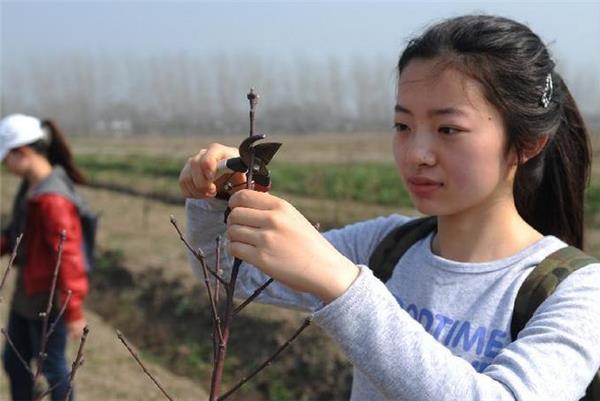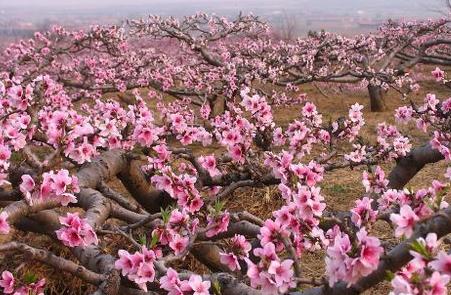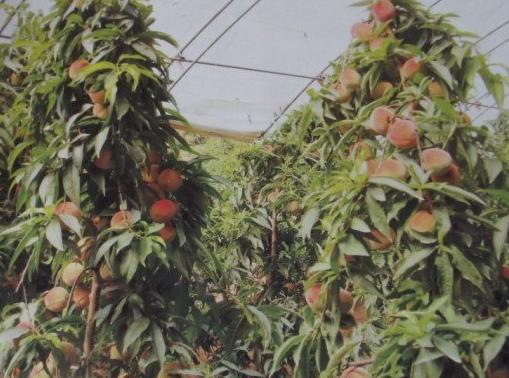Peach tree pruning techniques Peach tree pruning precautions
Peach trees like light, so it is necessary to adjust the growth, ventilation and light transmittance of the trees through timely pruning and pruning. In spring, wipe buds (buds and twigs that germinate on the back of the main branch). In summer, cut off the upright and vigorous vegetative branches, and the closed branches and branchlets in the hall. In autumn, continue to remove vegetative branches and continue to adjust light and ventilation to promote the formation of full flower buds. In winter, keep an appropriate amount of fruiting branches according to the tree potential. The pruning methods of thinning, releasing, cutting and shrinking are combined; young trees should maintain the leadership of the leading branches of the main branches (excluding competitive branches); for adult trees entering the full fruiting period, it is necessary to maintain the leadership of the leading branches of the main branches and control the infinite extension of the main branches. Today, the editor will introduce the techniques of peach tree pruning.

I. main points of shaping and pruning of young trees
The common tree shape of peach trees is the open heart shape of three main branches, and the fixed stem height of the seedlings is 60 to 70 square meters. More than 5 full buds should be used as plastic bands at 20 to 30 meters below the cutting mouth. In the first year, three straggled main branches are selected, and none of them should face due south. The first side branch was selected on each main branch in the second year, and the second side branch was selected in the third year. The length of the shearing of the main branch is 60 to 70 square meters per year. In order to increase the number of branches, two coring can be carried out during the growing period. During the growing period, branch pulling and other methods are used to control the opening angle, control the vigorous growth and promote the early fruit. Four-year-old trees should cultivate some fruiting branches and fruiting branches on the main and lateral branches. In order to grow fast and bear fruit early, young trees are mainly pruned in winter.
II. Key points of tree pruning in the early fruit stage
The initial fruit period is generally from the third to the sixth year after planting. The main task is to continue to cultivate backbone branches and pay attention to the cultivation of fruiting branches.
1. For the pruning of the main branch, the extended branch of the main branch should be selected, and the extended branch of the main branch should be cut short. If there is a better lateral auxiliary shoot at the 50-60 cm of the extended branch, the part above the secondary shoot can be cut off, and the secondary shoot can be used as an extended branch, and then the secondary shoot can be cut to 1max 2. In the part of lacking branches, it can be cut and reserved for 20 ~ 30 cm, which can be cultured into a better fruiting branch group, and the rest of the developed branches can be thinned from the base.

two。 The pruning of the side branch the selected side branch leaves the extended branch with 1x2 to remove the competitive branch and control its growth. the branch of the upper side branch can not be higher than or longer than the branch of the main branch, and always maintain a subordinate relationship.
3. Results most of the large fruiting branches in the branch group were selected to grow vigorously, which could be formed in 3 to 4 years after being cut short and thinned. A small group of fruiting branches is formed by dividing 2 or 4 fruiting branches through a short cut with a general robust branch. The large, medium and small fruiting branch groups should have the branch group to lengthen the branch, and constantly change the extension direction to make the branch group bend upward, restrain the upper strength and the lower weakness, and prevent the branch axis from being too long and the lower part bald.
4. In the pruning of fruiting branches, there are 8-10 flower buds in long fruit branches, 6-8 flower buds in middle fruit branches, 3-4 nodes in short fruit branches, and only sparse fruit branches in bouquets.
3. Main points of tree pruning in full fruiting period

1. In the early stage of pruning and bearing fruit, the extended branch of the main branch should be led by a strong branch, and the cutting length should be about 30 square meters. And use the opening angle of the auxiliary tip to slow down the tree potential. In the later stage of full fruit, the branches with small angle and strong growth potential were selected to raise the angle or retract the branches.
two。 The lower part of the pruning of the lateral branches was weakened, thinned or retracted into a large branch group. For the lateral branches that have room to grow, take the lead with strong branches. In this period, it is still necessary to adjust the principal-subordinate relationship between the principal and lateral branches. In summer pruning, attention should be paid to controlling strong branches, thinning dense branches and improving ventilation and light transmission conditions.
3. Results the pruning of branch groups can adjust the density between branch groups by thinning and retraction, so that it can be thinned from dense to thin, from weak to strong, and renewed. Keep good light. The general requirement is "scattered growth on both sides, uniform fiddling without shade, good arrangement of angle and direction, and a clear distinction of subordination."

4. The pruning of fruiting branches should be pruned according to the fruiting habits of the varieties. For the varieties with large fruit type but deep stalk depression and those without pollen, such as Zaofengwang and other varieties, the fruit of medium and short fruit branches is better, so light pruning is the main method in winter pruning, first thinning the erect branches and overdense branches on the back, and then re-pruning according to fruit setting and branch density. For long-blooming branches, you can also promote some medium and short fruit branches, which is the main fruit branch next year. In summer pruning, the short branches are promoted by picking the heart many times. When the tree potential begins to weaken, retract in time to promote strong branches and restore the tree potential. For the varieties with pollen and high fruit setting rate of medium and long fruit branches, they can be cut short according to the length and thickness of fruit branches. Generally, the long fruit branch is 20-30 cm, the middle fruit branch is 10-20 cm, and the lower node of the flower bud is shorter, and vice versa.
In order to adjust the relationship between growth and fruit, sufficient reserve branches should be retained through single-branch renewal and double-branch renewal. Single-branch and double-branch regeneration should be applied to the same plant at the same time. Generally speaking, single-branch regeneration should be used in young trees, and double-branch regeneration should be used in weak trees.

Single branch renewal: the long fruit branch should be cut and put properly. After the apex bears fruit, the branch will droop, the basal bud will be raised and new branches will be produced. It shrinks to the new branch when it is pruned the next year. This method is suitable for the high node position of flower buds or when there are no prepared branches at the back.
Double branch regeneration: in the biennial branchlet group, the upper and lower branches were selected, and the upper long fruit branch left 7-8 flower buds for fruiting; the lower branch only left 3-4 buds short at the base in order to produce strong fruit-bearing branches. When pruning in the second year, cut off the fruiting branches in the upper part, leave two strong branches in the lower part, and then prune them according to the above-mentioned method.
In summer pruning, the short branches are promoted by picking the heart many times. When the tree potential begins to weaken, retract in time to promote strong branches and restore the tree potential. For the varieties with pollen and high fruit setting rate of medium and long fruit branches, they can be cut short according to the length and thickness of fruit branches. Generally, the long fruit branch is 20-30 cm, the middle fruit branch is 10-20 cm, and the lower node of the flower bud is shorter, and vice versa.
In order to adjust the relationship between growth and fruit, sufficient reserve branches should be retained through single-branch renewal and double-branch renewal. Single-branch and double-branch regeneration should be applied to the same plant at the same time. Generally speaking, single-branch regeneration should be used in young trees, and double-branch regeneration should be used in weak trees.

Single branch renewal: the long fruit branch should be cut and put properly. After the apex bears fruit, the branch will droop, the basal bud will be raised and new branches will be produced. It shrinks to the new branch when it is pruned the next year. This method is suitable for the high node position of flower buds or when there are no prepared branches at the back.
Double branch regeneration: in the biennial branchlet group, the upper and lower branches were selected, and the upper long fruit branch left 7-8 flower buds for fruiting; the lower branch only left 3-4 buds short at the base in order to produce strong fruit-bearing branches. When pruning in the second year, cut off the fruiting branches in the upper part, leave two strong branches in the lower part, and then prune them according to the above-mentioned method.
Related
- Wuhan Hospital Iron Tree Blooming Result Was Instantly Frightened by the Gardener Master
- Which variety of camellia is the most fragrant and best? Which one do you like best?
- What is the small blue coat, the breeding methods and matters needing attention of the succulent plant
- Dormancy time and maintenance management of succulent plants during dormancy
- Minas succulent how to raise, Minas succulent plant pictures
- What are the varieties of winter succulent plants
- How to raise succulent plants in twelve rolls? let's take a look at some experience of breeding twelve rolls.
- Attention should be paid to water control for succulent plants during dormant period (winter and summer)
- Watering experience of twelve rolls of succulent plants
- Techniques for fertilizing succulent plants. An article will let you know how to fertilize succulent plants.



